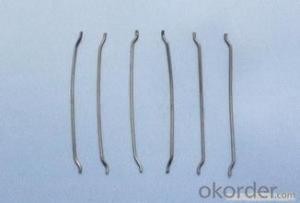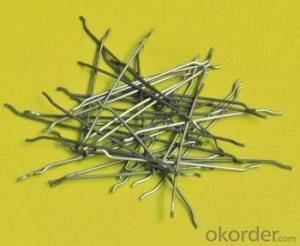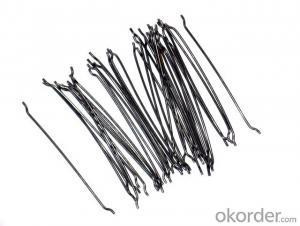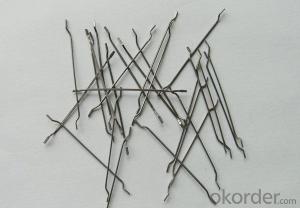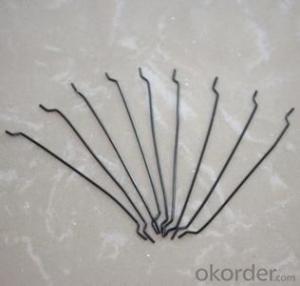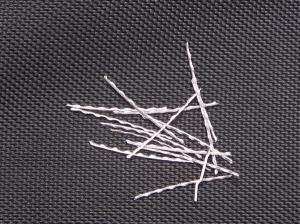Melt Extract Stainless Steel Fiber Loose from CNBM China
- Loading Port:
- Tianjin
- Payment Terms:
- TT OR LC
- Min Order Qty:
- 2000 kg
- Supply Capability:
- 30000 kg/month
OKorder Service Pledge
OKorder Financial Service
You Might Also Like
Quick Details
Place of Origin: Jiangsu, China (Mainland)
Model Number: HT-MC
Material: Color Steel
certificated: ISO 9001
Specifications
ISO 9001 certificated
2.70% for Europe, Middle Asia, America market
3.Have the most number of steel fiber machine in china
1. Material: low carbon steel wire or stainless steel
2.Diameter: 0.4mm-1.0mm
3.Length: meet your requirements
4.tensile strength >1000Mpa
6.Feature: excellent tensile,high tenacity,against cracking,impact and fatigue
7.Uses: highway road surface,tunnel,building,airport road surface and so on .
Straight Steel Fiber
1.ISO 9001 certificated
2.70% for Europe, Middle Asia, America market
3.Have the most number of steel fiber machine in china
Picture

Steel fiber
FAQ
certificated: ISO 9001
Technical advantages of Daye steel fiber:
A. Improve mechanical performance of concrete
B. Provide uniform distribution throughout concrete with excellent mixing
C. No balling or caking by adopt correct mixing method
D. Reduce concrete volume
E.Save construction time and cost
F.Reduce excavation volume
G.Available for jointless floor.
- Q: Does melt extract stainless steel fiber improve the resistance to freeze-thaw cycles of concrete?
- Yes, melt extract stainless steel fiber does improve the resistance to freeze-thaw cycles of concrete. The addition of stainless steel fibers in concrete helps to enhance its durability and performance by minimizing the detrimental effects of freeze-thaw cycles. When water freezes within the concrete, it expands and exerts pressure on the surrounding matrix, leading to cracking and eventual deterioration of the structure. However, the inclusion of melt extract stainless steel fibers helps to mitigate these issues. The fibers act as reinforcement within the concrete, providing additional strength and preventing the propagation of cracks. This reinforcement effectively enhances the resistance of the concrete to the damaging effects of freeze-thaw cycles. Moreover, melt extract stainless steel fibers have excellent corrosion resistance properties, which further contribute to the improved durability of the concrete. Unlike other types of fibers, stainless steel fibers do not corrode or degrade over time, ensuring their long-term effectiveness in enhancing freeze-thaw resistance. Overall, the addition of melt extract stainless steel fiber in concrete significantly improves its resistance to freeze-thaw cycles, preventing cracking and extending the lifespan of the structure.
- Q: Is melt extract stainless steel fiber compatible with all types of aggregate?
- No, melt extract stainless steel fiber is not compatible with all types of aggregate. The compatibility depends on various factors such as the composition and characteristics of the aggregate, the application requirements, and the specific properties of the fiber. It is important to consider the compatibility and performance of the fiber and aggregate combination in terms of bonding, dispersion, and overall effectiveness in achieving the desired performance. It is recommended to consult with experts or manufacturers to determine the compatibility of melt extract stainless steel fiber with different types of aggregate for specific applications.
- Q: How does melt extract stainless steel fiber affect the bond strength of shotcrete to substrate?
- Melt extract stainless steel fiber enhances the bond strength of shotcrete to substrate. Due to its unique properties, such as high tensile strength and excellent adhesion, the fiber reinforces the shotcrete matrix and creates a stronger bond with the substrate. This improved bond strength results in increased durability and resistance to cracking, ultimately enhancing the overall performance of shotcrete applications.
- Q: Does melt extract stainless steel fiber improve the resistance to chemical attack of concrete?
- Yes, melt extract stainless steel fiber can improve the resistance to chemical attack of concrete. Stainless steel fibers are known for their excellent corrosion resistance, making them highly resistant to chemical attack. When these fibers are added to concrete, they provide reinforcement and enhance the overall durability and resistance of the concrete against various chemical agents. Chemical attack on concrete can occur due to exposure to aggressive substances such as acids, alkalis, salts, and other corrosive chemicals. These substances can cause deterioration and weakening of the concrete structure over time. However, when melt extract stainless steel fibers are incorporated into the concrete mix, they create a network of reinforcement that helps to prevent the penetration of these chemicals into the concrete matrix. The stainless steel fibers act as a physical barrier, preventing the chemical agents from reaching the concrete and reducing the risk of chemical attack. Additionally, these fibers also improve the overall mechanical properties of the concrete, increasing its resistance to cracking and enhancing its ability to withstand chemical exposure. Furthermore, melt extract stainless steel fibers have high thermal stability, allowing them to withstand high temperatures, which is particularly beneficial in environments where concrete is exposed to extreme heat or fire. This increased resistance to heat can further protect the concrete from chemical attack, as some chemical reactions can be accelerated by elevated temperatures. In conclusion, the addition of melt extract stainless steel fiber to concrete can significantly improve its resistance to chemical attack. These fibers provide reinforcement, enhance mechanical properties, and act as a barrier against corrosive substances, ultimately increasing the lifespan and durability of the concrete structure.
- Q: What are the advantages of using melt extract stainless steel fiber in shotcrete applications?
- There are numerous benefits to utilizing melt extract stainless steel fiber in shotcrete applications. Firstly, the inclusion of these fibers significantly boosts the overall strength and durability of the shotcrete. Acting as reinforcement, the fibers add extra tensile strength to the material. This proves especially crucial in shotcrete applications that experience high levels of stress or impact. Secondly, the utilization of stainless steel fiber in shotcrete enhances its resistance to cracking and shrinkage. The fibers aid in the even distribution of stress throughout the material, reducing the likelihood of cracks. This proves particularly advantageous in shotcrete applications that need to withstand harsh environmental conditions or heavy loads. Furthermore, melt extract stainless steel fiber improves the material's resistance to corrosion. Stainless steel is renowned for its exceptional corrosion resistance properties, making it an ideal choice for shotcrete applications exposed to aggressive environments like marine structures or chemical plants. In addition, the incorporation of stainless steel fiber in shotcrete can contribute to an extended lifespan for the structure. By reducing cracking and enhancing durability, the material becomes more resistant to deterioration over time. This can result in significant cost savings in terms of maintenance and repair. Lastly, melt extract stainless steel fiber offers ease of application. The fibers can be effortlessly mixed into the shotcrete mixture, seamlessly integrating into the construction process. This simplifies the overall installation process and reduces the need for additional reinforcement techniques. To conclude, the advantages of using melt extract stainless steel fiber in shotcrete applications encompass improved durability, increased resistance to cracking and corrosion, an extended lifespan for the structure, and ease of application. These benefits establish it as the preferred choice for various shotcrete projects, ensuring long-term performance and cost-effectiveness.
- Q: What is the effect of melt extract stainless steel fiber on the fatigue resistance of concrete?
- The melt extract stainless steel fiber has a positive effect on the fatigue resistance of concrete. It helps to improve the overall durability and strength of the concrete, making it more resistant to fatigue failure under cyclic loading conditions. The fiber reinforcement enhances the ability of the concrete to withstand repeated stress and strain, reducing the risk of cracking and extending the service life of the structure.
- Q: Is melt extract stainless steel fiber compatible with different types of shotcrete accelerators?
- Different types of shotcrete accelerators can be used with melt extract stainless steel fiber, as they are compatible. Shotcrete accelerators are employed to quicken the setting and hardening processes of shotcrete or concrete. To enhance the mechanical properties and durability of the final product, melt extract stainless steel fibers are frequently incorporated into shotcrete mixes. These fibers, made from stainless steel, possess exceptional corrosion resistance, allowing them to be compatible with various shotcrete accelerators. The inclusion of melt extract stainless steel fibers can bolster the bond strength, crack resistance, and impact resistance of shotcrete, regardless of the accelerator type. Thus, it is safe to assert that melt extract stainless steel fiber is compatible with different types of shotcrete accelerators.
- Q: Can melt extract stainless steel fiber be used in thin-section concrete elements?
- Yes, melt extract stainless steel fiber can be used in thin-section concrete elements. These fibers are commonly added to concrete mixtures to enhance its mechanical properties, such as increasing its tensile strength, reducing cracking, and improving durability. When used in thin-section concrete elements, these fibers can effectively reinforce the concrete and prevent the development of cracks, ensuring the structural integrity of the element.
- Q: Can melt extract stainless steel fiber be used in asphalt or bitumen?
- Yes, melt extract stainless steel fiber can be used in asphalt or bitumen. The addition of stainless steel fibers enhances the mechanical properties of the asphalt mixture, improving its durability, crack resistance, and fatigue resistance. Moreover, stainless steel fibers can also help in reducing rutting and thermal cracking in asphalt pavements.
- Q: Can melt extract stainless steel fiber be used in nuclear power plant applications?
- Yes, melt extract stainless steel fiber can be used in nuclear power plant applications. Stainless steel fibers have excellent corrosion resistance, high temperature resistance, and good mechanical properties. These characteristics make them suitable for various critical applications in nuclear power plants, such as reinforcing concrete structures, improving the thermal and mechanical properties of concrete, and enhancing the overall structural integrity of the plant. Additionally, stainless steel fibers can provide enhanced resistance to radiation damage, which is crucial in the nuclear power plant environment. Therefore, melt extract stainless steel fiber is a reliable and effective material for use in nuclear power plant applications.
Send your message to us
Melt Extract Stainless Steel Fiber Loose from CNBM China
- Loading Port:
- Tianjin
- Payment Terms:
- TT OR LC
- Min Order Qty:
- 2000 kg
- Supply Capability:
- 30000 kg/month
OKorder Service Pledge
OKorder Financial Service
Similar products
Hot products
Hot Searches
Related keywords

